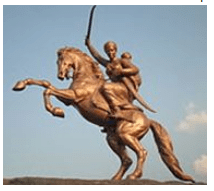Chapter Test: The Revolt of 1857-58 - 2 - CTET & State TET MCQ
10 Questions MCQ Test - Chapter Test: The Revolt of 1857-58 - 2
Which one of the following best describes a Resident with respect to British India?
Name the ruler of Kanpur who called himself Peshwa?
The attached picture shows the statue of a great personality kept in Solapur, Maharashtra. Identify her from the given clues:
She is from the kingdom of Jhansi
She wanted the East India Company to recognize her adopted son as the heir to the kingdom

She is from the kingdom of Jhansi
She wanted the East India Company to recognize her adopted son as the heir to the kingdom
By the mid 19th century, what actually happened to the Nawabs and Rajas in India?
Name the Governor General who declared that Awadh was being misgoverned and British rule was needed to ensure proper administration.
What did the East India Company do from the coins minted by the Company?
Identify the kingdom based on the clues given
One of the last territories to be annexed by the British
A subsidiary alliance was imposed here on 1801 and later taken over in 1856 by the British
Lord Dalhousie declared that the territory was being misgoverned and British rule was need to ensure proper administration
Identify this personality in the attached image, pleaded with the British to give his father's pension when the latter died?
In 1856, which Governor General decided that Bahadur Shah Zafar was the last Mughal King and none of his descendants would be recognized as Kings hereafter?
What did Lord Dalhousie announce after the death of King Bahadur Shah Zafar?


















